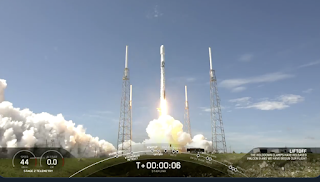Verizon set-up a trial Quantum Key Distribution (QKD) network in the Washington D.C. area.
 Live video was captured outside of three Verizon locations in the D.C. area, including the Washington DC Executive Briefing Center, the 5G Lab in D.C and Verizon’s Ashburn, VA office. Using a QKD network, quantum keys were created and exchanged over a fiber network between Verizon locations. Video streams were encrypted and delivered more securely allowing the recipient to see the video in real-time while ensuring hackers are instantly detected.
Live video was captured outside of three Verizon locations in the D.C. area, including the Washington DC Executive Briefing Center, the 5G Lab in D.C and Verizon’s Ashburn, VA office. Using a QKD network, quantum keys were created and exchanged over a fiber network between Verizon locations. Video streams were encrypted and delivered more securely allowing the recipient to see the video in real-time while ensuring hackers are instantly detected.
A QKD network derives cryptographic keys using the quantum properties of photons to prevent against eavesdropping. Verizon also demonstrated that data can be further secured with keys generated using a Quantum Random Number Generator (QRNG) that creates truly random numbers that can’t be predicted. With QKD, encryption keys are continuously generated and are immune to attacks because any disruption to the channel breaks the quantum state of photons signaling
eavesdroppers are present.
"The use of quantum mechanics is a great step forward in data security,” said Christina Richmond, analyst at IDC. “Verizon's own tests, as well other industry testing, have shown that deriving "secret keys" between two entities via light photons effectively blocks perfect cloning by an eavesdropper if a key intercept is attempted. Current technological breakthroughs have proven that both the quantum channel and encrypted data channel can be sent over a single optical fiber. Verizon has demonstrated this streamlined approach brings greater efficiency for practical large-scale implementation allowing keys to be securely shared over wide-ranging networks.”
https://www.verizon.com/about/news/verizon-achieves-milestone-future-proofing-data-hackers
 Live video was captured outside of three Verizon locations in the D.C. area, including the Washington DC Executive Briefing Center, the 5G Lab in D.C and Verizon’s Ashburn, VA office. Using a QKD network, quantum keys were created and exchanged over a fiber network between Verizon locations. Video streams were encrypted and delivered more securely allowing the recipient to see the video in real-time while ensuring hackers are instantly detected.
Live video was captured outside of three Verizon locations in the D.C. area, including the Washington DC Executive Briefing Center, the 5G Lab in D.C and Verizon’s Ashburn, VA office. Using a QKD network, quantum keys were created and exchanged over a fiber network between Verizon locations. Video streams were encrypted and delivered more securely allowing the recipient to see the video in real-time while ensuring hackers are instantly detected.A QKD network derives cryptographic keys using the quantum properties of photons to prevent against eavesdropping. Verizon also demonstrated that data can be further secured with keys generated using a Quantum Random Number Generator (QRNG) that creates truly random numbers that can’t be predicted. With QKD, encryption keys are continuously generated and are immune to attacks because any disruption to the channel breaks the quantum state of photons signaling
eavesdroppers are present.
"The use of quantum mechanics is a great step forward in data security,” said Christina Richmond, analyst at IDC. “Verizon's own tests, as well other industry testing, have shown that deriving "secret keys" between two entities via light photons effectively blocks perfect cloning by an eavesdropper if a key intercept is attempted. Current technological breakthroughs have proven that both the quantum channel and encrypted data channel can be sent over a single optical fiber. Verizon has demonstrated this streamlined approach brings greater efficiency for practical large-scale implementation allowing keys to be securely shared over wide-ranging networks.”
https://www.verizon.com/about/news/verizon-achieves-milestone-future-proofing-data-hackers


















